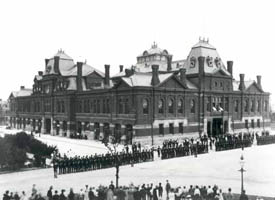- Details
 Mason County, located in Central Illinois between Peoria and Springfield, is located in what many call the “Imperial Valley of the Midwest.” In contrast to other farming areas around the state, Mason County fields include a large amount of sand. With modern irrigation technology, the fields have become plentiful for crops not commonly found in Illinois, including popcorn.
Mason County, located in Central Illinois between Peoria and Springfield, is located in what many call the “Imperial Valley of the Midwest.” In contrast to other farming areas around the state, Mason County fields include a large amount of sand. With modern irrigation technology, the fields have become plentiful for crops not commonly found in Illinois, including popcorn.
Nearly 20,000 acres of land in Mason County is dedicated towards producing popcorn, more than any other county nationwide. The county also is number one statewide in the number of acres dedicated to vegetables, snap beans and watermelon.
Learn more:
Nation’s top popcorn-producing county in Illinois (AgriNews)
- Details
 Steven Nagel was born in Canton on October 27, 1946. After graduating from Canton High School, Nagel received a Bachelor of Science degree in aerospace engineering from the University of Illinois and joined the Air Force. He logged nearly 10,000 hours of flight time and served a one-year tour as flight instructor in Southeast Asia in 1971 and 1972 while serving in the military.
Steven Nagel was born in Canton on October 27, 1946. After graduating from Canton High School, Nagel received a Bachelor of Science degree in aerospace engineering from the University of Illinois and joined the Air Force. He logged nearly 10,000 hours of flight time and served a one-year tour as flight instructor in Southeast Asia in 1971 and 1972 while serving in the military.
After receiving his master’s degree in mechanical engineering, Nagel joined NASA and became an astronaut in the summer of 1979. He first entered space aboard the Discovery on June 27, 1985, and would return three other times aboard the Challenger in 1985, Atlantis in 1991 and Columbia in 1993.
In total, Nagel spent 30 days, 1 hour and 34 minutes in space. He orbited the earth more than 100 times, performed repair missions on broken satellites and assisted in numerous scientific experiments and tests.
Learn more:
Read more about the life and achievements of Steven Nagel
- Details
 Nearly 5,000 runners turned out to the very first Chicago Marathon, then named the Mayor Daley Marathon, on September 25, 1977. The attendance made the inaugural marathon the largest marathon in the world at the time.
Nearly 5,000 runners turned out to the very first Chicago Marathon, then named the Mayor Daley Marathon, on September 25, 1977. The attendance made the inaugural marathon the largest marathon in the world at the time.
In 2006, marathon organizers teamed with four other races in Boston, London, Berlin and New York to create a series of qualifying competitions worldwide. Tokyo was recently added to that list, creating six World Marathon Majors.
The Bank of America 2015 Chicago Marathon was held October 11 and featured nearly 50,000 participants.
Learn more:
Read more about the history of the Chicago Marathon
- Details
 Did you know the fields surrounding Morton in Central Illinois supply much of the nation’s canned as well as ornamental pumpkins? The area is so well known it is commonly referred to as the “Pumpkin Capital of the World.” With an amiable climate and high-quality soils needed for pumpkin growth, Illinois produced a record 278,000 tons of pumpkins in 2013, making up 90 percent of the nation’s pumpkin production.
Did you know the fields surrounding Morton in Central Illinois supply much of the nation’s canned as well as ornamental pumpkins? The area is so well known it is commonly referred to as the “Pumpkin Capital of the World.” With an amiable climate and high-quality soils needed for pumpkin growth, Illinois produced a record 278,000 tons of pumpkins in 2013, making up 90 percent of the nation’s pumpkin production.
In celebration of pumpkins, the Morton Pumpkin Festival is held every year and draws more than 75,000 attendees to a four-day celebration offering all kinds of pumpkin-inspired treats as well as the infamous Punkin Chuckin’ Contest.
Learn more:
Read more on the impact pumpkin production has on Illinois’ economy
Illinois: The Great Pumpkin State
- Details
 George Pullman revolutionized long-distance rail travel in the 1860s with the invention of the Pullman Sleeping Car, a comfortable boxcar far superior to most accommodations of the time. The industrialist was also known for creating a workers’ community surrounding his factories just south of Chicago. The town of Pullman, Illinois grew to become internationally recognized for the level of offerings to its worker inhabitants. Gas and water hookups in each home, a large amount of green space and parks and other amenities distinguished Pullman from other company towns.
George Pullman revolutionized long-distance rail travel in the 1860s with the invention of the Pullman Sleeping Car, a comfortable boxcar far superior to most accommodations of the time. The industrialist was also known for creating a workers’ community surrounding his factories just south of Chicago. The town of Pullman, Illinois grew to become internationally recognized for the level of offerings to its worker inhabitants. Gas and water hookups in each home, a large amount of green space and parks and other amenities distinguished Pullman from other company towns.
While the community was known on the outside to be clean and progressive, tension between workers and factory owners was often high. A dramatic decrease in worker pay and benefits led to a violent strike in 1894 that left several dead and hundreds of rail cars burned. The strike and corresponding lock out of union workers would lead to several prominent and influential moments in American union history, including the celebration of the first Labor Day in 1894 and the rise of the nation’s first African-American union, the Brotherhood of Sleeping Car Porters.
After operations at the factories ceased in 1957, the neighborhood fell on hard times. With the area threatened with demolition in 1960, a group of residents advocated for its preservation and were successful in designating the area an Illinois Historic District in 1969 and a National Historic Landmark District in 1970. In February, President Obama designated the area a national monument, recognizing Illinois' history in the railroad industry and as a unique part of the birth of the labor rights movement in the United States.
Learn more:
Visiting the Pullman neighborhood? Click here for information on factory tours and tours of the famous Hotel Florence
Read more on the history of the Town of Pullman from the Chicago Historical Society
More Articles …
- Did You Know? Chicago’s first subway opened on this day in 1943
- Did You Know? Actor Craig Robinson is from Illinois
- Did You Know? Today is National Dessert Day
- Did You Know? Stanley Mazor, the co-inventor of the world’s first microprocessor, is from Illinois
- Did You Know? Country/folk singer and songwriter John Prine is from Illinois





